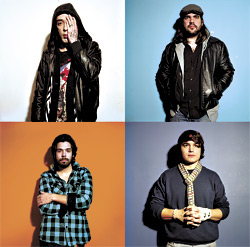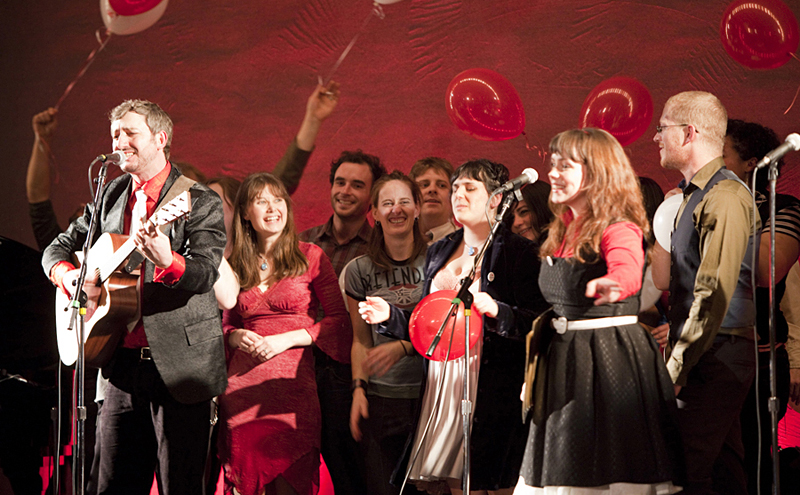Wolf Parade never really reeked of indie rock. Sure, they had some elements—Bowie yelps, stilted guitar riffs, fork-shoved-into-Atari keyboards—that made them fit neatly into that whole scene, but they always seemed kind of grizzly compared to most of those other bands. Seeing them at the Croc in 2005, they reminded me of early Modest Mouse: completely disorganized—the kind of group that is hell to gather in one room to make a decision. They look like a band that would fall to pieces were it not for duct tape and Ace bandages.
Whether this is truly the case or not, I have no clue. But I do know that, unlike the Shins or the Postal Service, Wolf Parade never seemed really eager to make anyone’s acquaintance (in other words, you wouldn’t be jamming out to them with your mom in her Nissan). It’s to our benefit that Wolf Parade keeps its distance; this is what always endeared them to me. It’s also why, I suspect, they arrive midway through 2008 with such a defiant album—and not some slick post-punk hand job.
At Mount Zoomer (due June 17) has nine songs, is 47 minutes long, and feels like Talking Heads’ Fear of Music or Patti Smith’s Horses. Like those classic albums, it sounds out of step with the times, with no real intention behind it except to be a good record. Maybe it’s a Canadian thing, but commercial gain seems the furthest thing from Wolf Parade’s mind. This album has no singles, includes a song that’s nearly 11 minutes long, and boasts few of the dramatic flareups of the band’s previous album, Apologies to the Queen Mary.
On that last go-round, Wolf Parade displayed a blatant division between its two principal songwriters, Spencer Krug and Dan Boeckner. Krug sounded like Bowie and Boeckner like Springsteen, and their respective songs sounded almost nothing alike—Apologies was sort of two albums rolled into one.
With At Mount Zoomer, however, Wolf Parade sounds like a band. The album gets rolling with a vintage-sounding keyboard-guitar lick before launching into the Television-ish crunch-bop chords of “Soldier’s Grin.” It’s a Boeckner song, and Krug’s keyboard lends an urban-freeway vibe as Boeckner sings, “In my head, there’s a city at night.” As with Iggy’s “The Passenger,” you can picture the headlights zipping by and the voyeuristic glow of lights from empty office buildings. When the chorus hits, Boeckner beams “But this place here is no friend of mine” in a very “Thunder Road”–like chin-up/shoulders-back manner. It’s become apparent this is one of Boeckner’s defining moments as a songwriter—one of many on this album.
Krug’s songs take on more of that spinning-carnival-military-march thing he’s so damned good at. But overall, he really takes a backseat on this record as compared to his role on Apologies. His songs here are less punchy than those but no less satisfying, especially “Call It A Ritual,” which features some of his most subdued and breezy vocals.
But most of Krug’s shiniest moments on Zoomer come when he’s backing up Boeckner. Krug adds such interesting sonic layers and folds to Boeckner’s songs that this may be the richest listen I’ve bought since Television’s Marquee Moon. And speaking of Television, “Fine Young Cannibals” fades out with an awesome back-and-forth guitar duel, replete with curly licks reminiscent of Tom Verlaine and Richard Lloyd’s.
Moments like this abound on Zoomer: the “Riders on the Storm”–esque organ tinkle of “California Dreamer,” the broad-chested, fist-pumping outro of “Language City,” and the various rhythms and parts contained in the epic closer “Kissing the Beehive.” This is the album’s real stunner, a song that only gains intensity as it drags on. It begins with Boeckner’s sandy style, then seamlessly changes tempo and melody, allowing Krug to enter with what are at first pretty vocals. But they then shift to pleading (“I wish I could believe in you!!”), only to snowball into a cymbal-bashing climax with Krug repeatedly bellowing “Fire in the hole!”
What the song is about, ultimately, I have no idea. But it’s clear Wolf Parade’s music is about tearing down walls and confronting fear head-on.
This record is full of that kind of imagery. Even the album artwork—a sprawling, Henry Darger–ish inner-sleeve illustration piece by Elizabeth Huey and Matt Moroz—overflows with everything Wolf Parade has come to embody in my twisted head. There are weird devils, Elizabethan figures, Shakespearean dancing goats, faces masked in tree bark, prisoners at the gallows, pink horses, winged dragons, and classic lovers-in-arms. The band has always been part royalty, part trash, part soldier, part nightmare, part machine, and part animal. But given all that, they still manage to sound more human than the rest of their glad-handing indie-rock peers.








